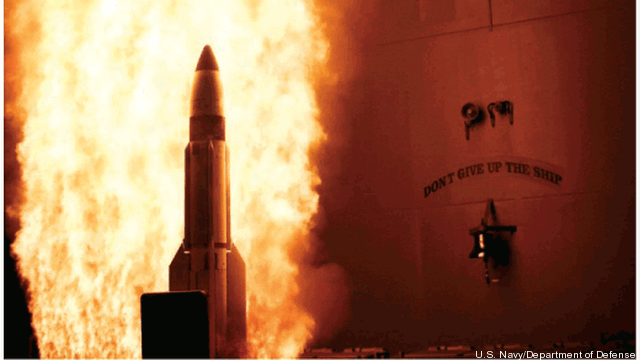 Washington: SM-3 proponents can breathe easy. The missile won’t be coming under the Pentagon’s budget ax anytime soon, according to a soon-to-be released DoD report.
Washington: SM-3 proponents can breathe easy. The missile won’t be coming under the Pentagon’s budget ax anytime soon, according to a soon-to-be released DoD report.
Members of the Defense Science Board briefed the Hill on the initial findings of that report, which focused on ballistic missile defense operations, particularly in the early launch phase.
What was clear from the briefing is that any option to try and intercept a short to medium-range missile just after the time of launch was “fundamentally impossible,” according to a source familiar with the SM-3 program.
Also clear to the DSB is “the SM-3 Block II A and B makes sense to them,” the source said, referring to the two latest versions of the missile.
How could one report come to such different conclusions on two issues that are tied so closely together? Its because they are not tied together at all, the source said.
The confusion came about when missile defense proponents assumed the board’s findings on the the early intercept mission — which focused on short to intermediate range threats — was a condemnation of the SM-3 missile program.
Funny thing is that, by design, the SM-3 was never intended to shoot down short-range missiles, especially at in the early launch stage, the source pointed out.
The newest version of the SM-3 missile, the Block IIB, is actually designed to extend the range of previous variants so it can hit long-range threats.
“Its not meant to go after firecrackers, bottle rockets, mortars, artillery, short-range missiles,” the source said. “So don’t be real surprised when someone says [early intercept] would be really hard,” for the SM-3.
Adding to that confusion was the DSB report was cited in a highly-critical report by the Congressional Budget Office on the SM-3.
Combined with the fact that DoD only briefed the Hill on the report’s preliminary findings this week, had “people leaping off the cliff of conclusions without understanding the context.”
In a July 6 letter to the Washington Times by the study’s co-chairs, former Air Force Vice Chief of Staff Gen. Lester Lyles and former Central Command chief Adm. William Fallon, attempted to set the record straight.
The letter, which will be as close as DoD will get to issuing a public version of the classified DSB report, stated the early intercept mission was near impossible due to “very short payload deployment times and the present absence of adequate sensors” not to flaws in the weapon itself. Which, again, was never meant to hit short and intermediate-range threats.
Summing the board’s findings on the SM-3, the source said: “It won’t do everything, but it makes sense.”
Connecticut lawmakers to grill Army, Lockheed about job cuts at Sikorsky helicopter unit
“The Connecticut delegation has questions about why, with that [FY24] appropriation in hand, this happened,” said Rep. Joe Courtney, D-Conn.


























